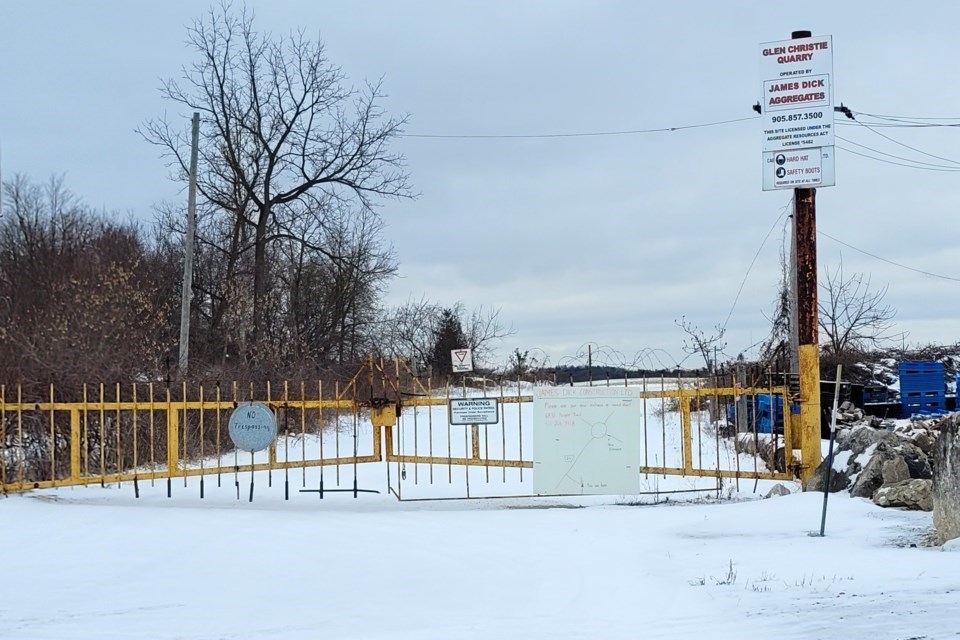PUSLINCH – A flood of concerns has been raised about a longstanding gravel quarry's application for a new water-taking permit and its potential impact on surrounding water sources and local drinking water.
Foremost, the effect the water taking could have on neighbouring private and municipal wells.
The township is a commenting agency on the application. It does not have final say.
Referencing new reports from Wellington Hydrogeology Ltd. (WHL) and Wellington Source Water Protection (WSWP), Puslinch council has opposed a new permit (PTTW) from John Dick Construction Limited, a Bolton-based gravel extraction company, to extract nearly 15 million litres of water per day for at least four months of the year, for up to 10 years at the Glen Christie Quarry at 2145 Waterloo Regional Road 24, in the northwest part of the township.
Submitted to the Ministry of Environment, Conservation and Parks (MECP) in October 2024, the application names two sources at the quarry where water is needed for "aggregate extraction dewatering purposes;" asking for amounts that qualify the permit as having the highest potential for "unacceptable environmental impactor interference."
One site, called Lower Quarry Lake, would see up to 13.7 million litres of water taken per day for up to 120 days per year for 10 years while the second, called Quarry Sump, would extract nearly a million litres per day every day for 10 years.
Presenting several recommendations at a Puslinch council meeting Wednesday afternoon, many of the WHL and WSWP's comments and concerns surrounded the "significant" dewatering proposed, which could result in "potential impacts to groundwater and surface water features."
Other concerns raised focused on reducing the PTTW length to five years, cumulative impacts with nearby operations, erosion and breach of the Speed River during periods of high river flows/flooding and the absence of an aquitard between the Guelph and the Gasport Formation within the site boundary.
Speaking during the meeting, Angie Mason, a senior hydrogeologist with WHL, said the proposed dewatering could significantly lower water levels by several metres in some private wells in Puslinch and Guelph\Eramosa if approved as is.
Disagreeing with the MTE's statement that municipal wells installed within the regional bedrock production aquifer versus the approved depth of the quarry "will not be adversely impacted by dewatering activities," Mason said potential impacts can't be ruled out given the site's geology, the proposed extension of the excavation into the Gasport Formation and the cumulative impacts with other proposed nearby water takings for aggregate extraction.
To avoid the "significant dewatering" proposed, WHL recommended subaqueous mining techniques be used on-site which would "significantly reduce the potential for impacts to nearby groundwater users, surface water features and wetlands."
Restricting the initial dewatering rate of 9,550 L/min to the first 120 days of dewatering only is also recommended.
WSWP said restricting the PTTW to a maximum of five years will mean water taking and monitoring data can be reviewed sooner and any needed adjustments can be considered.
Groundwater infiltration of the water being pumped from the quarry is recommended to mitigate the "significant drinking water threat for reduction of groundwater recharge."
At the meeting, all councillors agreed with the concerns raised by WSWP and WHL- supporting council's objection until the NSRI and ECA are available as well as additional information on cumulative impacts and potential breaching impacts.
Councillor John Sepulis later requested Puslinch be reimbursed for any third-party costs associated with the application.
"I think that's very important. I don't think we should be stuck as a municipality incurring those unnecessary costs," said Sepulis. "I'm concerned about this (application) starting to be a big problem."
Mayor James Seeley also shared concerns about not receiving the Environmental Compliance Approval (ECA) application and the NSRI report, which is related to natural heritage, as was requested.
According to the WSWP, despite "repeated correspondence with the MECP," they have not received supporting documentation for a concurrent ECA and are unclear about what is proposed within it, especially regarding discharge to surface water versus groundwater infiltration.
While the PTTW application references ecological/biological indicators for surface water features and wetlands in an NSRI report, the indicators, ecological significance of the surface water features and wetlands and how the monitoring program will protect these features were not explicitly outlined.
All councillor and report comments will be submitted to the MECP with respect to stormwater management and the PTTW.
With files from CambridgeToday.
Isabel Buckmaster is the Local Journalism Initiative reporter for GuelphToday. LJI is a federally-funded program.
